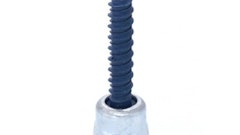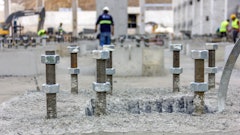
When building a new structure, it is critical to securely fasten items to the foundation or slab of concrete with the use of a sill plate. A sill plate, also known as a sole plate, is the bottom horizontal part of a wall or building to which the vertical studs will be attached.
Most sill plates are made from lumber - usually measuring 2" x 4", 2" x 6", 2" x 8" or 2" x10".
Before Getting Started
To ensure proper construction and safety, it is important to determine which fastening system will be the best choice for attaching the sill plates.
One method for fastening sill plates is the use of cast-in-place anchors, commonly referred to as "J" Bolts. "J" bolts are anchors in the shape of the letter J with threads on the end opposite of the bent end. These bolts are set in place before the concrete is poured.
The use of "J" bolts provides the best holding values, but can be problematic for the do-it-yourselfer due to the expertise needed for the complicated installation steps.
The "J" bolts must be installed completely perpendicular and, if not, numerous problems will occur when trying to attach the sill plate. Also, this method cannot be used when building a structure where there is an existing foundation, such as replacing a dilapidated garage.
For less complicated applications or for those with existing foundations, Wedge Anchors are a type of concrete anchor that can be successfully used with sill plates. This type of anchor is a post-installed anchor, meaning that it is placed in concrete after it is fully cured. These fasteners are designed for use in solid concrete only.
Wedge anchors are available in diameters measuring from 1/4" to 1 1/4".
The length of the wedge anchor is completely dependent upon the thickness of the material to be fastened. To determine the size of anchor needed, it is important to check local building codes or to consult with an engineer or architect. It is also critical to verify the holding values required for your particular application since the quality of concrete may widely vary.
Choosing the Required Size Wedge Anchors
Once the required holding values have been determined, use the link to the wedge anchor sizing chart to determine the appropriate diameter and length for the wedge anchors.
Other considerations when using wedge anchors include:
- Use a wedge anchor of suitable length for the specific application.
- To determine the suitable length for an application, use the following equation below:
Minimum embedment for the diameter being used.
Thickness of the material being fastened, thickness of the nut and washer equals minimum length of the wedge anchor needed. - Ensure that the anchor will be further than the minimum distance from the concrete edge. The rule of thumb is a minimum of five anchor diameters from the unsupported edge of the concrete.
For example, if your wedge anchor is 1/2" in diameter, it must be installed a minimum of 2 1/2" from the unsupported edge. - Determine the grade of steel and/or plating of the wedge anchor required for the specific application. Wedge anchors are available in three different finishes: zinc plated, hot-dipped galvanized, and stainless steel
Helpful Hint : It is critical to remember that hole diameter is equal to anchor diameter. This information will affect the holding values of your wedge anchors.
Step by Step Instructions
Concrete Wedge Anchors can be now be installed easily:
- On the concrete, mark where your holes will be drilled.
Remember that anchors must be placed a minimum of five anchor diameters from any unsupported edge, and there should be a minimum of ten anchor diameters between any two anchors. - Using a hammer drill, drill your holes using a carbide-tipped masonry bit. The hole diameter should be the same diameter as the wedge anchor.
- Clear the hole of all debris using compressed air, a shop-vac or wire brush.
- Before inserting the wedge anchor into the hole, be sure to place the washer on the head and thread the nut a couple of turns. By not fully threading the nut, the threads of the wedge anchor are protected.
- Carefully place the sill place in the correct position and insert the wedge anchors into each hole through the sill plate.
- Hammer anchors into every hole ensuring that they are installed to the desired depth and securely in place. This will be the supporting plate to which studs will be placed later in the renovation process. Secure placement is important for the overall safety of the structure.
- Using a torque wrench, tighten every nut to guarantee they are tightened to the required torque value.
Final Checks
When using concrete wedge anchors, it is important to remember:
- Wedge anchors are very effective when the concrete is in good condition and minimum edge distances and spacing are maintained.Hole size is critical to the holding values of the wedge anchor.
- Hole diameter is equal to the anchor diameter when using ANSI standard carbide bits.
- The tolerances of ANSI standard bits are specifically matched to work well with wedge anchors.
Finally, wedge anchors have a required torque value. Check this important anchor technical information page to determine the diameter of the anchor to use for a range of required torque values.
Ed. Note: This feature was supplied by Concrete Fastening Systems, Inc.: http://www.concretefasteners.com.




























